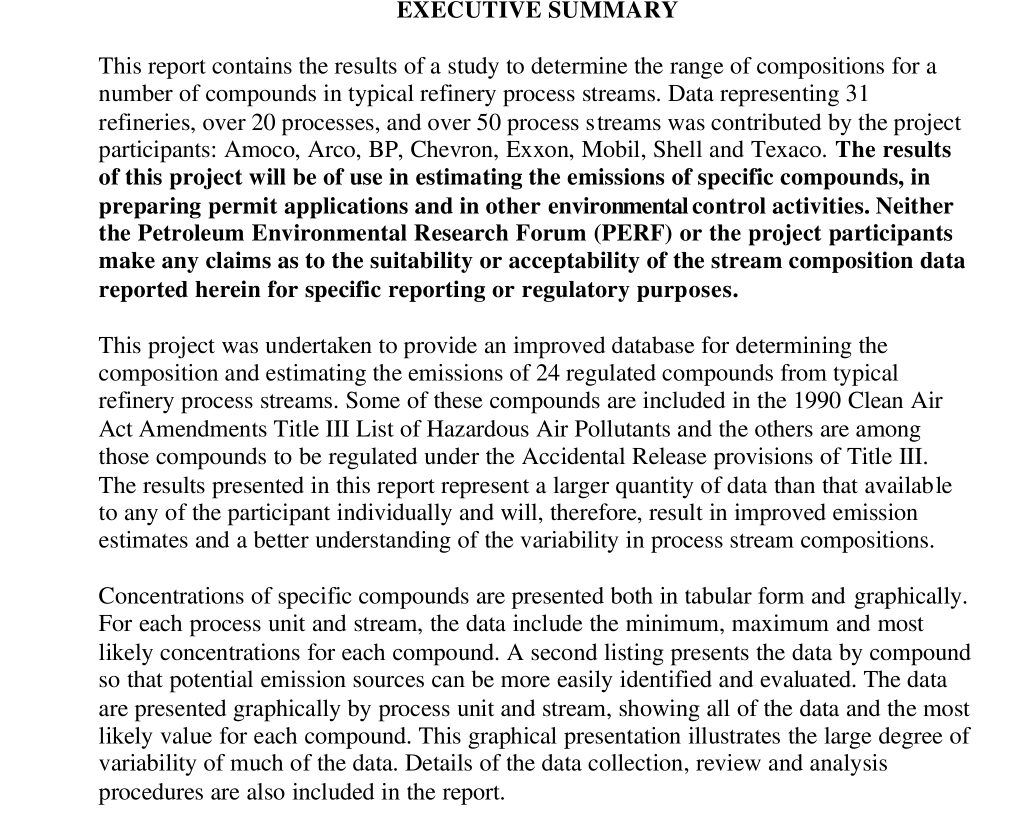API Publ 4723 pdf download

API Publ 4723 pdf download.ReÞnery Stream Speciation
The number of streams for any given unit in the TSCA report is overwhelming and many of the streams should have been combined. There are twenty one liquid streams and thirty eight gas streams listed for the atmospheric distillation unit and fifteen liquid streams listed for the vacuum distillation unit. Refineries do not operate this way and there would be no data available with such narrowly defined and overlapping ranges. The only workable alternative for this PERF project was to simplify the number of streams for any given unit and acknowledge the fact that there would be a range in composition for any given stream. . Even with this simple naming scheme used in this study, some“light” and“heavy” streams could have been combined because in some cases the streams’ physical properties may not have been adequately described for the data gatherer to know the exact boiling range of the stream. In addition, some refineries may have just one stream of a given type or may produce“light”,“medium”,“heavy” and“extra heavy” streams. Placing this type of data in the database added additional variability. The streams included in this report are summarized in Table 5-1 listed under the process units from which they are derived. The corresponding generic refinery streams flow diagrams are included in Figures 1 – 16. Figure 17 is an example of an integrated refinery.
The Clean Air Act Amendments of 1990 lists 189 compounds as Hazardous Air Pollutants (HAPs). However, many of these compounds such as pesticides, herbicides and halocarbons are not present in cnude oil refining. The entire HAPs list was considered by all project members including consultations with refinery operations experts at each company.’ The short list for data sharing was developed by consensus based on process knowledge and experience. In addition to the eighteen HAPs, there were also six additional compounds added to the list. These additional compounds are of interest for Accidental Release modeling. The HAPs and accidental release compounds included in this study are listed in Table 4-2. A class of compounds called “Polycyclic Organic Matter”is included as a HAP under the CAA Amendments. Although some compounds that belong to this class are expected to be present in crude oil and some refinery streams and products, the participants opted not to include this type of compounds in this study because POMs are poorly defined in the CAA Amendments and there is virtually no data available as a class or as individual species. In addition, target analytes within that class would have to be identified before any data could be collected. Before any information could be gathered on stream composition, it was necessary to agree upon a stream naming convention. There are several reasons why this is a very crit:ical step in the data gathering process. Names for the same type of stream from a similar unit may be different from one refinery to the next. For example, the same cut from a crude distillation unit may be called“straight run”naphtha at one location and “virgin” naphtha at another site. A much more difcult problem is the way streams are “cut”or the boiling ranges for the particular stream. A refner may choose to produce a sin,gle stream out of a reformer or may choose to split the reformer output into two boiling ranges. In one case only a“reformate” is produced whereas in another case, there could be a“light” and a “heavy” reformate. These streams can be quite variable in composition with one having significant concentrations of benzene and another with little or no berizene. Additional variability could be encountered depending on the boiling range or carbon number range of the feed to the reformer.









